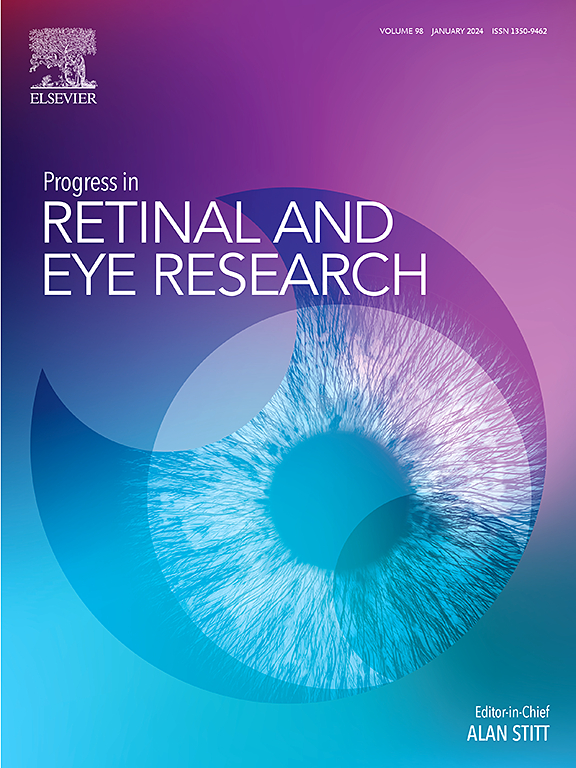Advances and therapeutic opportunities in visual cycle modulation
IF 14.7
1区 医学
Q1 OPHTHALMOLOGY
引用次数: 0
Abstract
The visual cycle is a metabolic pathway that enables continuous vision by regenerating the 11-cis-retinal chromophore for photoreceptors opsins. Although integral to normal visual function, the flux of retinoids through this cycle can contribute to a range of retinal pathologies, including Stargardt disease, age-related macular degeneration, and diabetic retinopathy. In such conditions, intermediates and byproducts of the visual cycle, such as bisretinoid components of lipofuscin, can accumulate, concomitant with cellular damage and eventual photoreceptor loss. This has inspired efforts to modulate the visual cycle, aiming to slow or prevent the formation of these toxic intermediates and thus preserve retinal structure and function. Over the past two decades, multiple strategies to modulate the visual cycle have emerged. These include both intrinsic approaches, targeting key enzymes, retinoid-binding proteins, or receptors within the pigment epithelium or photoreceptors (e.g., RPE65, CRBP1, and rhodopsin inhibitors/antagonists) and extrinsic strategies that indirectly alter retinoid availability within the retina (e.g., RBP4 antagonists). Many of these agents have shown promise in animal models of visual cycle-associated retinal diseases, reducing pathological changes, and improving retinal survival. Several have advanced into clinical studies, although none are currently FDA-approved. Challenges remain in optimizing drug specificity and duration of action while minimizing side effects such as nyctalopia. In this review, we comprehensively examine current and emerging visual cycle modulators, discuss their medicinal chemistry, mechanisms of action, efficacy in preclinical and clinical studies, and highlight future opportunities for drug discovery aimed at safely and effectively preserving vision through modulation of this biochemical pathway.
视觉周期调节的进展和治疗机会
视觉循环是一种代谢途径,通过再生光感受器视蛋白的11-顺式视网膜发色团来实现连续视觉。尽管类维甲酸是正常视觉功能的组成部分,但在这个循环中,类维甲酸的流动可导致一系列视网膜病变,包括Stargardt病、年龄相关性黄斑变性和糖尿病性视网膜病变。在这种情况下,视觉循环的中间体和副产物,如脂褐素的类双维甲酸成分,可以积累,伴随细胞损伤和最终的光感受器丧失。这激发了调节视觉周期的努力,旨在减缓或阻止这些有毒中间体的形成,从而保持视网膜的结构和功能。在过去的二十年里,出现了多种调节视觉周期的策略。这些方法包括内在方法,针对关键酶、类视黄酮结合蛋白或色素上皮或光感受器内的受体(例如,RPE65、CRBP1和视紫红质抑制剂/拮抗剂)和间接改变视网膜内类视黄酮可用性的外在策略(例如,RBP4拮抗剂)。许多这些药物在视觉周期相关视网膜疾病的动物模型中显示出希望,减少病理改变,提高视网膜存活率。有几种已经进入临床研究,尽管目前没有一种获得fda批准。挑战仍然是优化药物特异性和作用时间,同时尽量减少副作用,如夜盲症。在这篇综述中,我们全面研究了当前和新兴的视觉周期调节剂,讨论了它们的药物化学、作用机制、临床前和临床研究中的疗效,并强调了未来通过调节这一生化途径安全有效地保护视力的药物发现机会。
本文章由计算机程序翻译,如有差异,请以英文原文为准。
求助全文
约1分钟内获得全文
求助全文
来源期刊
CiteScore
34.10
自引率
5.10%
发文量
78
期刊介绍:
Progress in Retinal and Eye Research is a Reviews-only journal. By invitation, leading experts write on basic and clinical aspects of the eye in a style appealing to molecular biologists, neuroscientists and physiologists, as well as to vision researchers and ophthalmologists.
The journal covers all aspects of eye research, including topics pertaining to the retina and pigment epithelial layer, cornea, tears, lacrimal glands, aqueous humour, iris, ciliary body, trabeculum, lens, vitreous humour and diseases such as dry-eye, inflammation, keratoconus, corneal dystrophy, glaucoma and cataract.

 求助内容:
求助内容: 应助结果提醒方式:
应助结果提醒方式:


